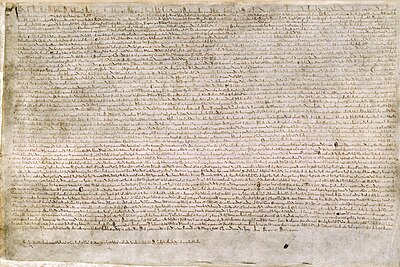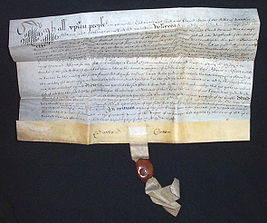Vellum


Vellum is prepared animal skin or membrane, typically used as writing material. It is often distinguished from parchment, either by being made from calfskin (rather than the skin of other animals),[1] or simply by being of a higher quality.[2] Vellum is prepared for writing and printing on single pages, scrolls, and codices (books).
Modern scholars and experts often prefer to use the broader term "membrane", which avoids the need to draw a distinction between vellum and parchment.[2][3]: 9–10 It may be very hard to determine the animal species involved (let alone its age) without detailed scientific analysis.[4]
Vellum is generally smooth and durable, but there are great variations in its texture which are affected by the way it is made and the quality of the skin. The making involves the cleaning, bleaching, stretching on a frame (a "herse"), and scraping of the skin with a crescent-shaped knife (a "lunarium" or "lunellum"). To create tension, the process goes back and forth between scraping, wetting and drying. Scratching the surface with pumice, and treating with lime or chalk to make it suitable for writing or printing ink can create a final look.[1]
Modern "paper vellum" is made of synthetic plant material, and gets its name from its similar usage and high quality. It is used for a variety of purposes including tracing, technical drawings, plans and blueprints.[5][6][7]
Terminology

The word "vellum" is borrowed from
To-day the distinction, among collectors of manuscripts, is that vellum is a highly refined form of skin, parchment a cruder form, usually thick, harsh, less highly polished than vellum, but with no distinction between skin of calf, or sheep, or of goat.[11]
French sources, closer to the original etymology, tend to define velin as from calf only, while the
Manufacture

Vellum allows some light to pass through it. It is made from the skin of a young animal. The skin is washed with water and lime (calcium hydroxide), and then soaked in lime for several days to soften and remove the hair.[14] Once clear, the two sides of the skin are distinct: the body side and the hairy side. The "inside body side" of the skin is usually the lighter and more refined of the two. The hair follicles may be visible on the outer side, together with any scars from when the animal was alive. The membrane can also show the pattern of the animal's vein network called the "veining" of the sheet.[15]
The makers remove any remaining hair ("scudding") and dry the skin by attaching it to a frame (a "herse").[3]: 11 They attach the skin at points around the edge with cords and wrap the part next to these points around a pebble (a "pippin").[3]: 11 They then use a crescent shaped knife, (a "lunarium" or "lunellum"), to clean off any remaining hairs.
The makers thoroughly clean the skin and process it into sheets once it is completely dry. They can extract many sheets from the piece of skin. The number of sheets depends on the size of the skin and the required length and breadth of each individual sheet. For example, the average calfskin could provide roughly three and a half medium sheets of writing material. The makers can double it when they fold the skin into two conjoined leaves, also known as a bifolium. Historians have found evidence of manuscripts where the scribe wrote down the medieval instructions now followed by modern membrane makers.[16] The makers rubbed them with a round, flat object ("pouncing") to ensure that the ink would adhere to the surface.[15] Even so, ink would gradually flake off of the membrane, especially if it was used in a scroll that was frequently rolled and unrolled.
Manuscripts

Preparing manuscripts
Once the vellum is prepared, traditionally a
Usage
Most of the finer sort of medieval manuscripts, whether
A quarter of the 180-copy edition of Johannes Gutenberg's first Bible printed in 1455 with movable type was also printed on vellum, presumably because his market expected this for a high-quality book. Paper was used for most book-printing, as it was cheaper and easier to process through a printing press and to bind. The twelfth-century Winchester Bible was also written on approximately 250 calfskins.
In art, vellum was used for paintings, especially if they needed to be sent long distances, before
Lasting in excess of 1,000 years—for example, Pastoral Care (Troyes, Bibliothèque Municipale, MS 504), dates from about 600 and is in excellent condition—animal vellum can be far more durable than paper. For this reason, many important documents are written on animal vellum, such as diplomas. Referring to a diploma as a "sheepskin" alludes to the time when diplomas were written on vellum made from animal hides.
Modern usage
British
Today, because of low demand and complicated manufacturing process, animal vellum is expensive and hard to find.
Vellum is still used for Jewish scrolls, of the
The Catholic Church still issues its decrees and diplomas for its officials on vellum.
Paper vellum
Modern imitation vellum is made from plasticized
Preservation
Vellum is ideally stored in a stable environment with constant temperature and 30% (± 5%)
See also
Notes
- ^ a b "Differences between Parchment, Vellum and Paper". archives.gov. Retrieved 2016-06-16.
- ^ ISBN 978-0-8108-3922-9.
- ^ ISBN 978-0-8014-3863-9.
- ISBN 0-85967-967-5.
- ^ Hepler, Wallach & Hepler 2012, pp. 60–61.
- ^ a b "Japanese vellum - CAMEO". cameo.mfa.org. Archived from the original on 2017-09-03. Retrieved 2017-09-03.
- ^ a b "How Modern Day Vellum Stationery Is Produced". The Note Pad | Stationery & Party Etiquette Blog by American Stationery. 2011-07-04. Archived from the original on 2017-09-03. Retrieved 2017-09-03.
- ^ "vellum". Online Etymological Dictionary. Retrieved 2014-08-09.
- ISBN 978-0-393-24479-3. Archivedfrom the original on 2016-12-02. Retrieved 2 December 2016.
- ^ William Horman, Vulgaria (1519), fol. 80v; cited in Ustick 1936, p. 440.
- ^ Ustick 1936, p. 440.
- ^ Johnston, E. (1906 et seq.) Writing, Illuminating, and Lettering; Lamb, C.M. (ed.)(1956) The Calligrapher's Handbook; and publications of Society of Scribes & Illuminators
- ^ "The Making of a Medieval Book". The J. Paul Getty Trust. Archived from the original on 2010-11-25. Retrieved 2010-11-19.
- ^ a b ""Recording the physical features of Codex Sinaiticus". Codex Sinaiticus, in partnership with the British Library". Archived from the original on 2012-05-01. Retrieved 2012-04-02.
- ^ Thompson, Daniel. "Medieval Parchment-Making". The Library 16, no. 4 (1935).
- ^ "Goat skin tradition wins the day". BBC News Online. 1999-11-02. Archived from the original on 2008-04-09. Retrieved 2016-02-11.
Acts of Parliament dating back to 1497 recorded on vellum are currently held in the House of Lords Public Record Office
- ^ "Frequently Asked Questions about the Houses of the Oireachtas - Tithe an Oireachtais". Oireachtas. Archived from the original on 2012-03-28. Retrieved 2016-02-11.
Once a Bill has been passed by both Houses, the Taoiseach presents a vellum copy of the Bill, prepared in the Office of the Houses of the Oireachtas to the President for signature and promulgation as law.
- ^ Hughes, Laura (2016-02-09). "Thousand year old tradition of printing Britain's laws on vellum has been scrapped to save just £80,000". The Daily Telegraph. Archived from the original on 2016-02-12. Retrieved 2016-02-11.
- ^ Hughes, Laura (2016-02-14). "Vellum should be saved in a bid to 'safeguard our great traditions', says minister". The Daily Telegraph. Archived from the original on 2016-02-13. Retrieved 2016-02-15.
Mr Hancock told The Daily Telegraph: 'Recording our laws on vellum is a millennium long tradition, and surprisingly cost effective. While the world around us constantly changes, we should safeguard some of our great traditions and not let the use of vellum die out.'
- ^ "Vellum: printing record copies of public Acts". House of Commons Library. 15 August 2018. Retrieved 12 March 2021.
- ^ "Nowhere to hide: the value of vellum". ICLR. Retrieved 2023-11-08.
- ISBN 1118310446, 781118310441, google
- ^ Eric F. Hansen and Steve N. Lee, "The Effects of Relative Humidity on Some Physical Properties of Modern Vellum: Implications for the Optimum Relative Humidity for the Display and Storage of Parchment", The Book and Paper Group Annual (1991).
- ^ "Parchment/Vellum: Cold Storage - Research Projects - Preservation Science (Preservation, Library of Congress)". www.loc.gov. Retrieved 2022-03-19.
- ^ "Tips on Caring for Works on Parchment" (PDF). Iowa Conservation And Preservation Consortium. Retrieved 2023-04-01.
References
- Hepler, Dana J.; Wallach, Paul Ross; Hepler, Donald (2012). Drafting and Design for Architecture & Construction (9th ed.). Cengage Learning. ISBN 978-1111128135.
- Hingley, Mark (2001). "Success in the Treatment of Parchment and Vellum using a Suction Table". Journal of the Society of Archivists. 22 (1): 71–77. S2CID 110087014.
- Ustick, W. Lee (1936). "'Parchment' and 'vellum'". The Library. 4th ser. 16 (4): 439–43. .
- Lyons, Martyn (2011). Books a Living History. Thames & Hudson. pp. 22, 43, 57. ISBN 978-0-500-29115-3.
External links
- On-line demonstration of the preparation of vellum from the BNF, Paris—text in French, but mostly visual.
